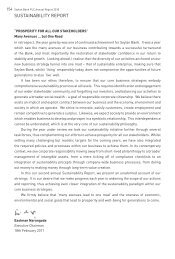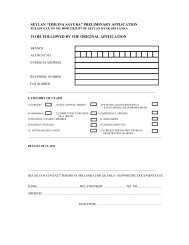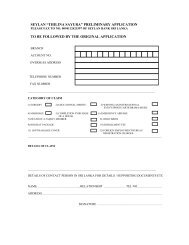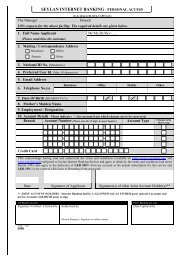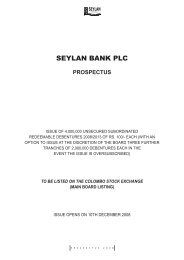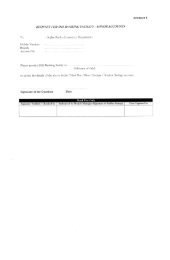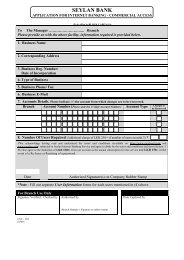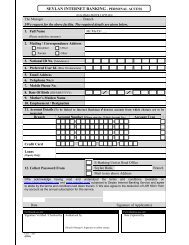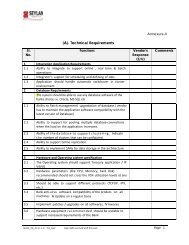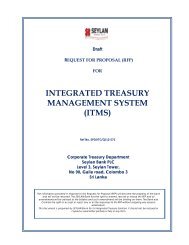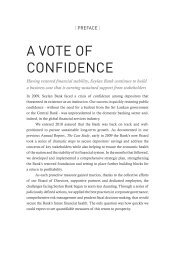The Case Study - Seylan Bank
The Case Study - Seylan Bank
The Case Study - Seylan Bank
Create successful ePaper yourself
Turn your PDF publications into a flip-book with our unique Google optimized e-Paper software.
<strong>Seylan</strong> <strong>Bank</strong> PLC Annual Report 2009 147Notes to the Consolidated Financial Statements1.4.6.2 General Provision<strong>The</strong> general provisions cover loan losses inherent in portfolios with similar credit risk characteristics(e.g., portfolio of loans, advances and lease receivables), when there is objective evidence to suggest thatthey contain impaired loans, but the individual impaired loans cannot yet be identified. In assessing the needfor general provision for loan losses, management considers factors such as credit quality, portfolio size,concentrations and economic factors. In order to estimate the required provisions, assumptions are madeto define the way inherent losses are determined based on historical experience.<strong>The</strong> amount of potential losses not specifically identified but which experience indicates are presentin the portfolio of loans, advances and lease receivables are recognised as a general provision in theIncome Statement.In addition, the direction issued by the Monetary Board of the Central <strong>Bank</strong> of Sri Lanka, in terms of Section46 of the <strong>Bank</strong>ing Act No. 30 of 1988, as amended, in ‘Requirements to Maintain a General Provision forAdvances’ requires all licensed commercial banks to maintain a general provision of 1% of the total on BalanceSheet, performing loans and advances and on Balance Sheet overdue loans and advances, net of interest insuspense and credit facilities secured by cash deposits, gold or Government Securities with the same bank. <strong>The</strong>general provision was commenced with a minimum of 0.1% provision as at 31st December 2006 and thereafterincremental provisions were made on the same basis till 31st March 2009, with the view of meeting the totalprovision requirement of 1% by 31st March 2009.1.4.7 Investments1.4.7.1 Investments in SubsidiariesInvestments in subsidiaries are stated at cost in the <strong>Bank</strong>’s Financial Statements in accordance with theSri Lanka Accounting Standard 26 on Consolidated Financial Statements and Accounting for Investmentsin Subsidiaries.1.4.7.2 Investments in AssociatesInvestments in associates are accounted under the Equity Method in Consolidated Financial Statements inaccordance with the Sri Lanka Accounting Standard 27 on Accounting for Investments in Associates.1.4.7.3 Dealing Securities<strong>The</strong>se are marketable securities acquired and held with the intention to resale over a short period of time.Such securities are recorded at market values, adjustments for changes in market values are accounted forin the Income Statement. In classifying securities as ‘Dealing’ (Trading), the <strong>Bank</strong> has determined that itmeets the description for such classification.1.4.7.4 Investment Securities<strong>The</strong>se are acquired and held for yield or capital growth in the medium/long term. Such securities arerecorded at cost. Changes in market values of these securities are not taken into account unless there isconsidered to be a permanent diminution in value. In classifying securities as ‘Investment’, the <strong>Bank</strong> hasdetermined that it has both the positive intention and ability to hold the securities until their maturity date.Unquoted long-term investments are stated at cost.1.4.7.5 Investment PropertiesInvestment properties are properties held either to earn rental income or for capital appreciation or bothbut not for sale in the ordinary course of business, used in the production or supply of goods or services orfor administrative purposes.



